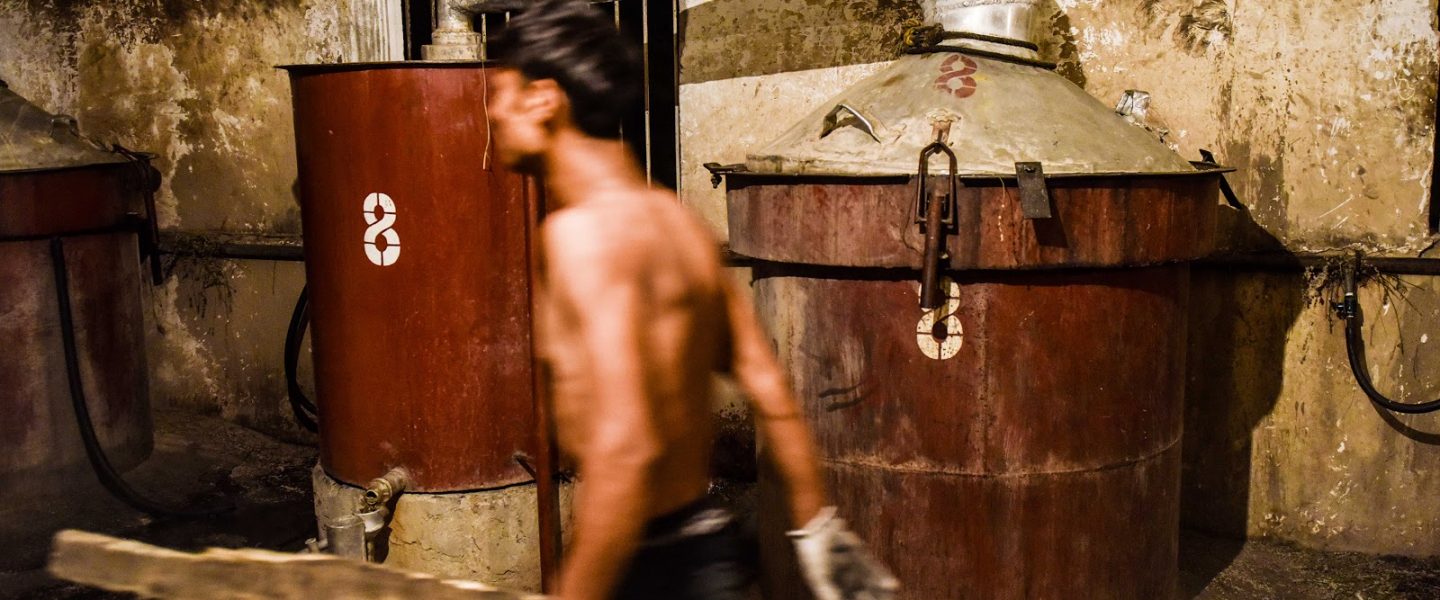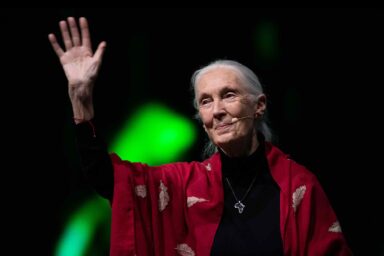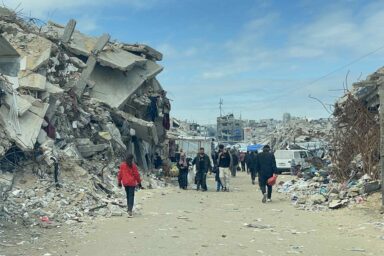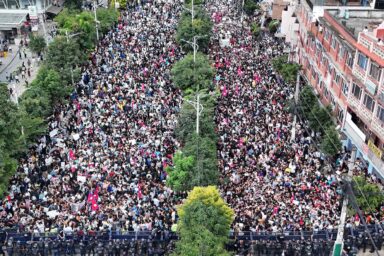Brutal slave labor in China is responsible for many of our daily consumer products. And global corporations collaborating with the Chinese government know all about it — and profit from it.
Avoiding Chinese goods is not an option. The world’s largest manufacturing economy is also the largest global exporter of goods, and the second largest importer. Even amid the pandemic, China is still the world fastest growing consumer market and the only major economy to grow in the past year.
Yet its human rights abuses and the consequence of its authoritarian rule should concern us all. Forced-labor camps are manufacturing products ranging from cheap goods to BMW and Mercedes parts — all as a part of the world’s largest slave-labor system.
Our guest on this week’s WhoWhatWhy podcast, investigative journalist Amelia Pang, has spent years examining abuses inside China. She is the recipient of a Los Angeles Press Club award for her undercover reporting on the exploitation of smuggled immigrants who are recruited from Asia to work in Chinese restaurants. Her most recent work is Made in China: A Prisoner, an SOS Letter, and the Hidden Cost of America’s Cheap Goods.
She tells the story of an Oregon mother who opened a $5 package of Halloween decorations — cheap foam headstones — and something unexpected fell out: an SOS letter, handwritten in broken English by the prisoner who’d made and packaged the item.
In looking at the proliferation of slave labor camps inside China, Pang focuses on the inhuman,15-hour-a-day working conditions, and the plight of Muslim Uyghurs, whose internment has exploded the size of these modern-day gulags.
She also explains why many of what might be considered to be “good factories” sometimes outsource some of their work to these slave-labor camps.
Pang discusses why there has been so little worldwide outrage to all of this, as she highlights the direct connection between China’s trillion-dollar Belt and Road initiative, and the enslavement of the Uyghurs.
The only hope for the future, according to Pang, is a trustworthy, international registry of goods that are certified forced-labor-free, with global buy-in from manufacturers as well as sellers like Walmart and Amazon.



Click HERE to Download Mp3
Full Text Transcript:
| Jeff Schechtman: | Welcome to the WhoWhatWhy podcast. I’m your host, Jeff Schechtman. China represents the world’s largest manufacturing economy. It’s the largest global exporter of goods, the second largest importer, and the world’s fastest growing consumer market. This past year, China’s economy grew at the slowest pace in more than four decades, but remains the only major economy in the world to have expanded in 2020. China cannot be ignored. |
| Jeff Schechtman: | Its global ambitions continue to grow, and it’s even very much part of the debate taking place in this country about the minimum wage. Its human rights abuses and the human consequences of its authoritarian rule must also be a part of the picture. How do we reconcile all this? While small but noble efforts to boycott Chinese goods sound nice, the reality and practicality is questionable. Get in any car, use any ATM, any phone, watch any TV, type on any computer, and the odds are you’re interacting with Chinese goods. |
| Jeff Schechtman: | Maybe for the Amish it’s easy, but for the rest of us, not so much. So perhaps what we really have to do is begin to understand exactly the scope of the problem. And to help us do this, I’m joined by our guest Amelia Pang. Amelia Pang is an award-winning journalist. She’s written for publications, including Mother Jones and the New Republic. She has been awarded for her investigative journalism uncovering the exploitation of smuggled immigrants who were recruited to work in Chinese restaurants. |
| Jeff Schechtman: | She’s also the author, most recently, of Made in China, a look at the hidden costs of Chinese goods. And it is my pleasure to welcome Amelia Pang here to the WhoWhatWhy podcast. Amelia, thanks so much for joining us. |
| Amelia Pang: | Thank you so much for having me. |
| Jeff Schechtman: | First of all, tell us a little bit about the story that really opens up what you write about in Made in China; the woman in Oregon that found this note inside some Halloween decoration. |
| Amelia Pang: | Yes. In 2012, an American woman named Julie Keith opens up this brand-new package of Halloween decorations from Kmart and out falls a SOS letter that’s written by the political prisoner who had made and packaged this very product in a labor camp in China. My book tells his story, what happened to him in the end. |
| Amelia Pang: | But it also takes a deep look at the problems in our supply chain and the deeply flawed ways that a lot of our corporations are auditing their Chinese factories and all the different factors that made it easy for something that was manufactured in a labor camp to end up selling at a Kmart in Portland, Oregon. |
| Jeff Schechtman: | Is this problem with the forced labor manufacturing products, is this something that is with respect only to cheap goods from China, or is it across the board, even more sophisticated goods? |
| Amelia Pang: | Oh, it is across the board. It is definitely not limited of cheap goods. Actually, last year, the Australian Strategic Policy Institute released a terrific report which documented 82 major global brands, some of them quite expensive, there’s hard evidence that they’re using Uyghur forced laborers. The Uyghurs are Muslim-Turk minority group that are being detained en masse in China. And some of those brands that were using these forced laborers included BMW, Mercedes-Benz, Nike, and Lacoste. These are not cheap dollar store brands. |
| Amelia Pang: | Consumers are paying a high price for their products and really they have the resources to do better, and we should be pushing them to. |
| Jeff Schechtman: | Given how pervasive this is then across the board, not just as you say cheap goods, but whether it’s Apple, whether it’s a BMW, or Mercedes, or whatever, where are the pressure points? Where are the places that people can think about taking some kind of action or creating some kind of political pressure that makes a difference? |
| Amelia Pang: | Yes, there’s several pressure points. And this all goes back to the reasons why these factories are outsourcing work to forced labor camps are deeply connected to us as global consumers and the way that we shop. A lot of times, if our company is offering too low of a price for the normal factory to make this product, then the factory often has no choice but to outsource work to places like labor camps where workers can make the products for free. |
| Amelia Pang: | Or if their company doesn’t actually give the factory a realistic amount of time to actually produce the merchandise because they’re trying to capitalize on much as they can in the latest fast-fashion trend, then the factory does have to secretly outsource some work to some really shady places like labor camps where prisoners can be forced to work the entire night to meet a production deadline if they have to. There’s nobody watching out for them. |
| Jeff Schechtman: | Is it more complex with hybrid products, something in a car or in a computer, where parts are manufactured all over the place, where you don’t even know where the particular Chinese parts are made? |
| Amelia Pang: | Right. There’s so many products like that where, even if it says it’s made in the USA or another country, the raw materials could be made in China. It could be made in a labor camp in China. |
| Jeff Schechtman: | Given that, how are consumers supposed to know? Is there an argument to be made for more transparency, with respect to these products? |
| Amelia Pang: | Exactly. I think we need to start demanding more transparency. I don’t think the solution is necessarily to avoid all made-in-China products entirely, because a lot of people can’t do that. I mean, everything is made in China and a lot of people cannot afford to just pay higher prices to get everything from a locally made source. The issue is transparency, yes. |
| Amelia Pang: | I think what we can realistically do is the next time you go shopping online at your favorite store’s website, just take a moment and look at their sustainability page or their corporate social responsibility page and see what it says exactly. A lot of times these pages aren’t revealing enough information. And Made in China is ultimately about educating consumers how to judge and analyze those pages. What are some key things you should be looking for? |
| Amelia Pang: | If your favorite company doesn’t contain these types of information then you can go to social media. You can go to Twitter, and go to Facebook, and publicly criticize them and push them to do better. |
| Jeff Schechtman: | To what extent does the problem a growing one in China? |
| Amelia Pang: | It is growing at a rapid pace. We’re seeing with the rise of the Uyghur detention camps. I’m sure many of your listeners may have heard of the news that there’s anywhere between 1.5 million to 3 million Uyghurs currently detained in camps and many of them do have to do forced labor. These camps are associated with cotton fields. They’re really making a wide range of products, everything from the raw materials for solar panels, human hair extensions, and even personal protective equipment. And a lot of these goods are being exported to the US. |
| Jeff Schechtman: | Talk a little bit about the manufacturing companies themselves in China and the degree to which they are complicit in some of this, even some of the big name companies. |
| Amelia Pang: | Yes, it’s actually no secret in the industry that these manufacturers collaborate with prison camps all the time. I went to China to actually see the camps myself and follow the trucks to see which manufacturers they were working with. When you arrive at the camp site, the guards and the employees in the camps will welcome you to buy from them if you mention that you’re from an overseas company looking to source from them. They’re not even trying to hide it. They’re so used to communicating with business people this way and manufacturers this way. |
| Amelia Pang: | And if you just wait outside and follow the trucks, you see that they go to all kinds of manufacturers. I followed trucks to an Apple manufacturer, a factory that made school supplies, a factory that made pet products. When you look at the customs records, most of them are exporting to the US, and Europe, and all over the world. |
| Jeff Schechtman: | Are there any companies that you have found in China that are refusing to partake of their involvement in using forced labor? |
| Amelia Pang: | Yeah, that’s a really interesting point. The reality is, there’s so many factories in China, and they’re all so competitive with each other to try to get a contract with a major global brand like our brands. Once they can get such a contract, they don’t really want to do anything to upset them or potentially lose the contract. Like for example, sourcing from an illegal labor camp. |
| Amelia Pang: | So a lot of the times when they do something like that, they’re often pushed to the brink and they have no choice because they simply cannot actually make the products at that cheaper price or make it for that fast of a turnaround. Really, brands need to be more transparent about how they’re sourcing from their factories. For example, what if the brand makes a last minute production change? Do they waive the late shipment penalty fees, which can be quite high? |
| Amelia Pang: | To give you an anecdotal example, a hypothetical example to show how the process works, let’s say a brand like H&M or Kmart or Walmart, they put in an order for 100,000 black hats from one factory. But all of a sudden, the celebrity starts wearing lime green hats. And so now everybody wants to buy lime green colors and neon colors for their clothing. |
| Amelia Pang: | Some of these retailers are going to quickly change that order, very large order, for black hats to lime greens. A pretty big and significant production change, but they may not give them a deadline extension to make such a large change. And if the factory can’t actually make this big change in such a short amount of time, then they’re going to have to outsource work to some places with pretty poor working conditions. |
| Amelia Pang: | One Chinese auditor actually said to me, it’s a quote that I find really revealing, ‘A lot of corporations are auditing their Chinese factories to make sure they’re following the rules, but nobody is auditing the corporations to see if their sourcing practices actually make it even possible for their factories to follow the rules.’ |
| Jeff Schechtman: | When we talk about the poor working conditions, there’ve been so many stories about poor working conditions even in the non-forced labor factories in China. Talk about that and the nexus between the two. |
| Amelia Pang: | Yes, there are certainly even regular factories that do have poor working conditions like underage workers, just paying below minimum wage, or places with pretty low quality of life. You see with the Foxconn factories associated with Apple that there were several suicides in the factory over the years. But there’s also good factories that’s not the representative of the conditions of that factory. So there’s a mix of both. |
| Jeff Schechtman: | Is there any kind of a database anywhere, either formally or informally, that talks about what the good factories are and the products and brands that are coming out of those factories so that this can be looked at in a positive context as opposed to only a negative one? |
| Amelia Pang: | I think it’s hard to say or hard to point to a specific database. I think what we have to start looking at is the types of audits that our company is conducting for their factories. For example, not all audits are made equal. You have standard audits that might cost a couple hundred dollars that would typically only check for some simple things like the cleanliness of the factory, how well the product is made, if the equipment is working properly. These cheaper audits cannot detect something as hidden as illegal subcontracting to labor camps. |
| Amelia Pang: | They may not even interview the workers to really document their working conditions or whether the facility is really a safe place for their workers. And then you had more extensive audits that might cost $1,000 or more, and they would look into things like how the workers are doing. These are called social compliance audits. And then you have even more expensive audits that costs $5,000 or more. They take five days for auditors to complete. These audits, they cross-analyze the wage documents about different departments of the factory. |
| Amelia Pang: | And auditors have told me the third kind, the really expensive ones that take five days to do, are the only ones that could potentially detect secret subcontracting to labor camps. But how many companies are actually doing those audits? Nobody really reveals … I think very few companies reveal exactly, in great detail, what kind of audits they’re conducting. |
| Jeff Schechtman: | Talk a little bit about the relationship between the government in China and these companies that own these factories and that do this manufacturing. |
| Amelia Pang: | Yes. These are state-owned labor camps. A lot of times they are operated by the police department. The government is very involved, because these are places where the Chinese government can hide and detain dissidents, political dissidents, pro-democracy activists, civil rights lawyers, religious dissidents, such as underground Christian, the Falun Gong movement, Tibetans, ethnic minorities. These people can be detained arbitrarily for an indefinite period of time. Unless it’s a prison, most of these other facilities are not actually. |
| Amelia Pang: | The detainees don’t actually go to trial and receive an official sentence in court. They don’t have access to lawyers. They’re just kind of placed there arbitrarily by the police. It’s terrifying, gruesome conditions. There’s a lot of torture that happens. People have to stay up 15 to 20 hours a day working. And in some cases, even 24 hours a day when there’s a really big production deadline and demand for that product. And a lot of people die and just get buried in unmarked graves. These are really horrific places that were initially based off Soviet gulags. |
| Jeff Schechtman: | Is there any idea of what percentage of China’s manufacturing output comes out of these factories? |
| Amelia Pang: | It’s really hard to say because there isn’t one reliable source that covers all of the camps. We kind of have to rely on various human rights groups and journalists that are collecting data on the camps here and there trying to document how many there are. But to this day, we don’t have a complete picture of just how many camps there are. We just know that China definitely has the largest forced labor system that still exists today. |
| Jeff Schechtman: | What is the political pressure, if any, inside China to do away with, or to at the very least expose these camps? |
| Amelia Pang: | There was some efforts to close reeducation through labor camps, which is one type of labor camp in China that are pretty notorious. It was actually quite inspiring. Even the domestic media that are state-owned managed to cover this issue before getting shut down and punished for it. You saw people really caring and wanting change in China. But as an authoritative regime, they responded to keep people happy and not spark any potential for a mass democracy movement. China issued some policies and said they closed reeducation through labor camps a few years ago. |
| Amelia Pang: | But a lot of human rights organizations, including Human Rights Watch, have documented that these camps have not actually closed. They’ve simply been renamed as compulsory isolation drug detox centers a lot of the times. I actually visited some compulsory isolation drug detox centers and they very much don’t look like labor camps. There’s barbed wires everywhere, there’s guards. And even when you talk to the employees at the so-called drug detox centers, they don’t refer to this place as a detox center. They call it a prison still. |
| Jeff Schechtman: | What is the attitude of the workers that are working in big factories, places like Foxconn or some of the big factories that are not forced labor? How do they look upon the work that’s being done in these camps? |
| Amelia Pang: | When you talk to manufacturers, a lot of them just say, ‘Yeah, that’s what people do. People outsource work to prison labor. It’s pretty common.’ Actually, the crazy thing is it’s not illegal in China for domestic companies to source work from forced labor facilities and to sell the products domestically. It’s only illegal for the camps to export the products, although that law is rarely enforced and these camps are still exporting products all the time. |
| Jeff Schechtman: | But it does create, arguably, downward pressure on wages in the other factories, in the legitimate factories. |
| Amelia Pang: | To some extent yes. It does hurt the workers in regular factories too. |
| Jeff Schechtman: | Talk a little bit about how you see this playing out in the next few years. |
| Amelia Pang: | Unfortunately, I don’t see an end to this problem. We see the rise of the camps. They’re still rising exponentially in places like Xinjiang and in the prison camps that are associated with the Uyghur forced labor due to China’s intense crackdown on Uyghurs at the moment. I think, unless there’s some kind of a mass movement for our corporations to pull out of Xinjiang — which is a region that is heavily associated with forced labor — and to cut ties with factories that are known to use forced labor, then nothing will change. |
| Amelia Pang: | I mean, a year ago, the Australian Strategic Policy Institute found 82 companies, including, like I said, BMW, Mercedes-Benz, sourcing from Uyghur forced labor. It’s been a year and not many of those 82 companies have actually dropped those suppliers because nobody has really held them accountable or asked them to. Consumers are still buying from them. I think with more awareness … it takes awareness as the first step to create change. |
| Jeff Schechtman: | Talk a little bit about the Uyghur situation. That seems to have grown quite a bit larger in the past six months or so. |
| Amelia Pang: | Yes, it is a very dire situation. The US government has actually recognized that what’s currently happening with the Uyghurs can qualify as a genocide. Just between 2015 and 2018, forced sterilization and forced abortions led to an 84 percent decrease in population in two of the largest Uyghur prefectures in China. And that meets one of the five UN criteria for genocide, which is the suppression of birth. When we buy products that are associated with Uyghur forced labor, we are buying products that have an association with the genocide. |
| Jeff Schechtman: | And where does the Falun Gong fit into this equation? |
| Amelia Pang: | Yes, they are also predominantly. … If anybody is caught practicing Falun Gong, which is a Buddhist meditation movement that is banned in China, then they end up in labor camps. The Falun Gong is an interesting group because they do have a unique ability to organize protests and resistance movements in a way that. … They organized a pretty large one in the late ‘90s, one that hadn’t been seen in China since the 1989 pro-democracy movement. That was very concerning for the Chinese government, and they’ve been tracking down on Falun Gong followers ever since. |
| Jeff Schechtman: | Is there much pushback? We talked at the beginning about how large China’s export manufacturing business is. Is there any pushback to this anywhere else in the world? |
| Amelia Pang: | Yeah, the European trade deal was initially supposed to include certain requirements for human rights, but they didn’t in the end. The pushback really hasn’t been very, very strong. One area where we’re really seeing the weakness of the pushback from countries that you would expect to push back are most of the majority countries in the Middle East. |
| Amelia Pang: | Since the majority of the Uyghurs that are currently detained in China are Muslims, you would expect them to stand up to their fellow people, but they haven’t because China has invested so much money in being trading partners with these countries. At the end of the day, they’re not really standing up to this egregious human rights abuse. |
| Jeff Schechtman: | And China’s tentacles are strongly in places in the world, even in Africa as a result of Belt and Road. |
| Amelia Pang: | Yes, absolutely. The Belt and Road, I’m so glad you brought it up. Actually, the Belt and Road Initiative is deeply connected to the reason for the spark and the rise of the Uyghur camps. The Belt and Road Initiative, for listeners who may not be familiar, is a trillion-dollar economic development strategy that connects China to a lot of trading partners all over the world. There’s about 70 countries that are involved. |
| Amelia Pang: | Xinjiang, China, which is where the most of the Uyghurs live in Northwestern China, that area is a huge transportation hub and holds significant logistical importance to the Belt and Road Initiative, because Xinjiang is a region that connects China to the Middle East, to West Asia, and Europe. China is really, really afraid of any potential Uyghur uprisings due to the very poor conditions they’ve been living in for decades. You really saw a rise in arbitrary Uyghur arrests and detainment as the Belt and Road Investments took off. |
| Amelia Pang: | In 2017, China invested $66 billion in infrastructure in Xinjiang as part of the Belt and Road Initiative. And in 2017 was where you really saw a massive, massive rise in arrests of the Uyghurs and having people disappear into labor camps. |
| Jeff Schechtman: | There are many Chinese business executives that have immigrated out of China and around the world, some in the US, some in Europe, some in Australia. Are they concerned about this as it relates to China’s image, to whatever business interests they still have there? |
| Amelia Pang: | Unfortunately, you don’t see a whole lot of business leaders who are concerned, whether it’s Chinese business owners or Western business owners. As late as 2019, you hear people, CEOs who say, ‘Oh, I haven’t heard of the Uyghur conditions in Xinjiang. From what I can tell, it’s all going quite well over there.’ |
| Jeff Schechtman: | Is there an understanding that some of these concerns, with respect to the human rights abuses and these camps with the Uyghurs, really are part of this whole forced labor system? I mean, that’s where the understanding seems to not really be getting through, I think, to a lot of people. |
| Amelia Pang: | Right, yes. And a lot of these camps, they do have to do manufacturing work. They received their so-called political education and a lot of the torture that happens in some facilities. If that facility doesn’t have a manufacturing site, they’ll be bussed over to a neighboring factory, or even cotton fields, to do manufacturing work. And they’re paid far below minimum wage. They don’t really have the freedom to not do the work or to go to a different factory. They don’t have the freedom to see their families and visit their homes or on weekends. |
| Amelia Pang: | These are not free working conditions at all. This is forced labor. It’s so bad that auditors can’t even go to Xinjiang to independently inspect the factories for forced labor. So there’s really no way for a Western corporation to guarantee that the products they’re getting from Xinjiang is not made by forced labor. |
| Jeff Schechtman: | What about the argument that you hear often that the degree to which the economy in China continues to grow, that that will ultimately be the best medicine for this? As the economy grows, as China becomes a continuing part of the international community, that some of these practices will have to be abandoned. Do you buy that argument at all? |
| Amelia Pang: | That was the hope in the earlier days, but I don’t think there’s many people who are saying that anymore in either political parties in the US. We’re really seeing that China’s human rights conditions have worsened in recent years, despite their continual economic growth. With the rise of Xi Jinping, the leader of China now, he has made himself the lifelong leader. He’s removed term limits. He has a kind of authoritarian cult-like personality that you really haven’t seen since the days of Mao. |
| Jeff Schechtman: | Amelia Pang, her most recent book is Made in China. Amelia, I thank you so much for spending time with us today, here on the WhoWhatWhy podcast. |
| Amelia Pang: | Thank you so much for having me. I appreciate it. |
| Jeff Schechtman: | Thank you and thank you for listening and for joining us here on Radio WhoWhatWhy. I hope you join us next week for another Radio WhoWhatWhy podcast. I’m Jeff Schechtman. If you liked this podcast, please feel free to share and help others find it by rating and reviewing it on iTunes. You can also support this podcast and all the work we do by going to whowhatwhy.org/donate. |
Related front page panorama photo credit: Adapted by WhoWhatWhy from Angus Fraser / Flickr (CC BY 2.0) and Ben Grantham / Flickr (CC BY 2.0).



